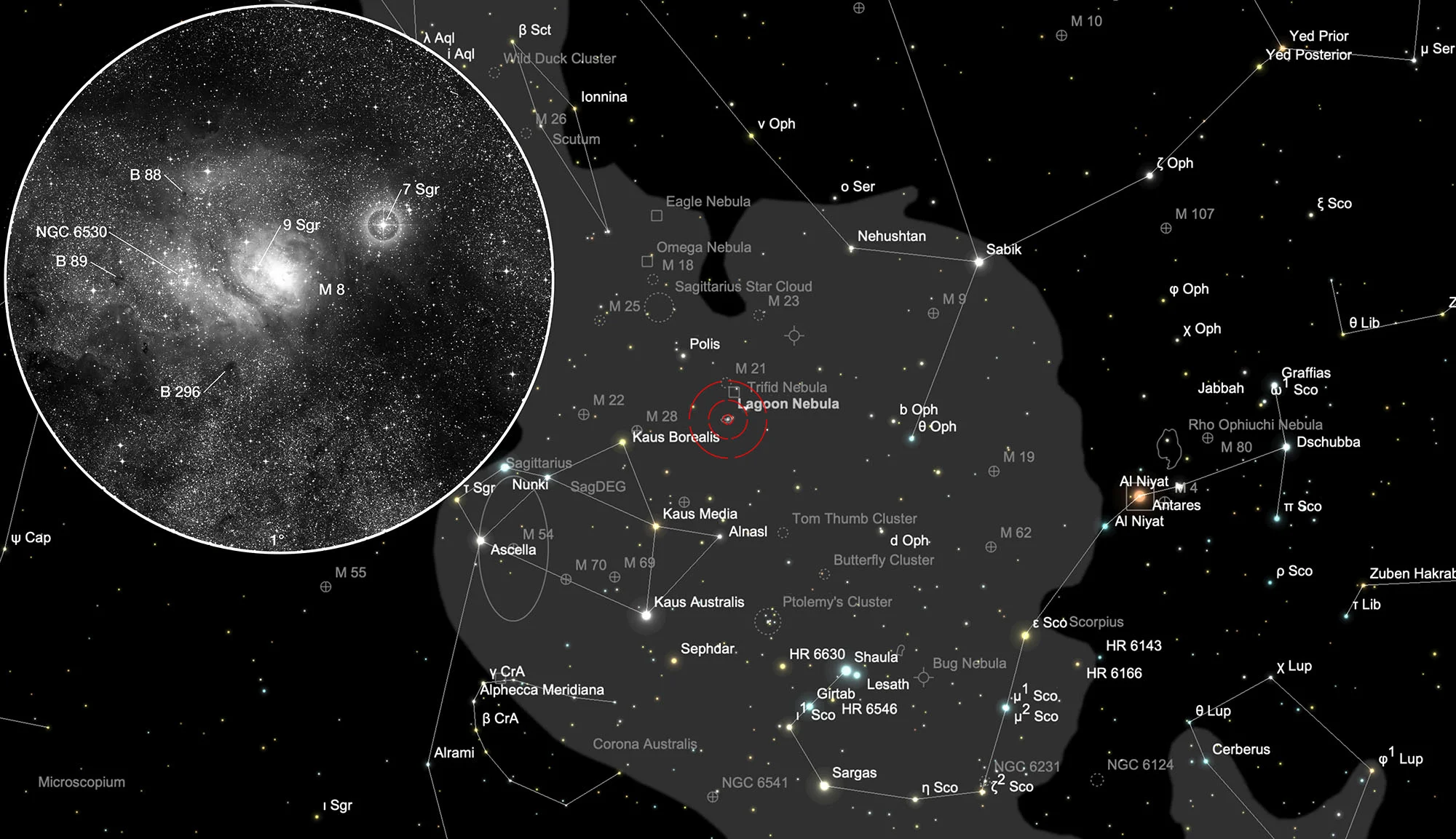Lagoon Nebula (Messier 8)
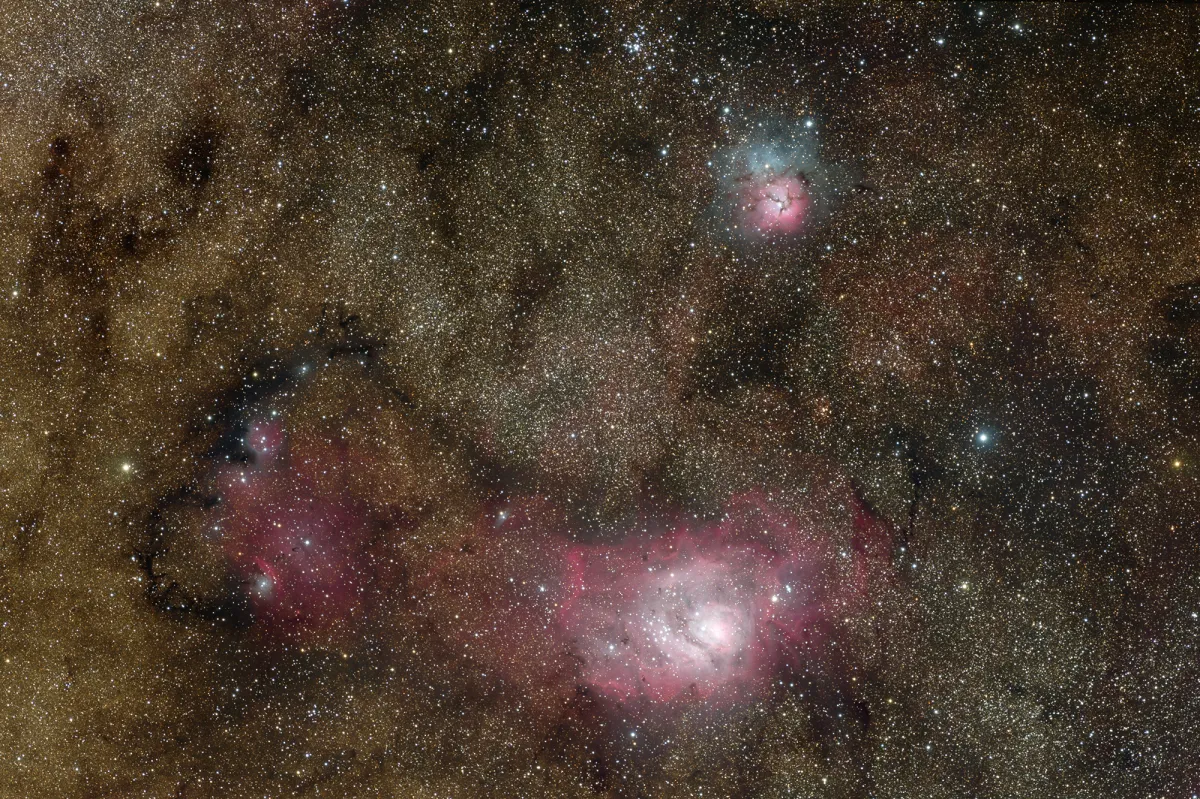
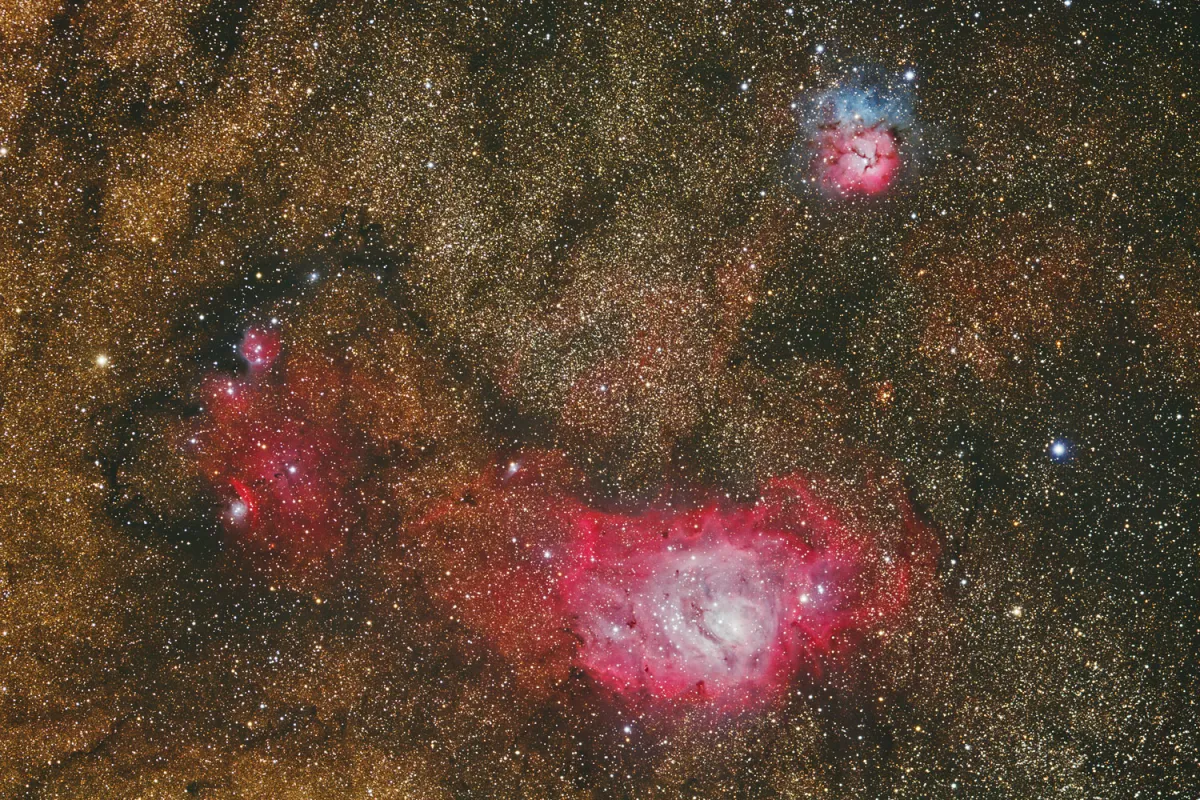
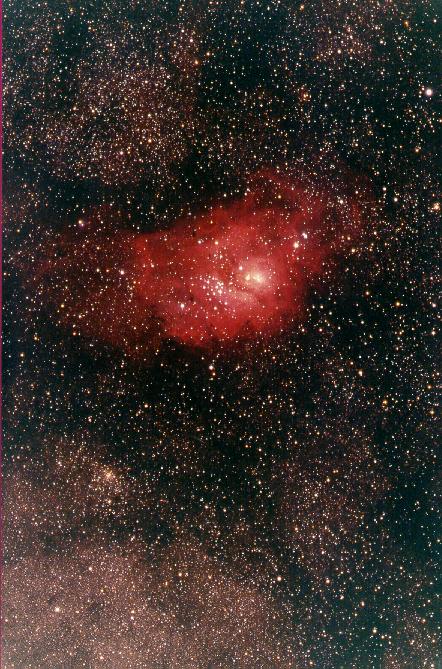
History
The Lagoon Nebula is one of the most magnificent objects in the sky. The discovery is often attributed to Le Gentil in 1747, but it appears that the nebula was already recorded by Flamsteed in 1680 as a nebulous «extension in the arch of Sagittarius». De Cheseaux also referred in 1746 to a «Cluster in Sagittarius' arch», which presumably represented M 8. Charles Messier included the nebula in 1764 as the eighth object in his list of comet-like celestial objects.
Physical Properties
M 8 is a galactic nebula, an H II region, the birthplace of new stars. The most notable detail is the dark curved channel that crosses the nebula from NE to SW, seemingly splitting it in half. This canal is two arc minutes wide in most places, but it is not completely dark, but rather traversed by parallel running light filaments, mostly on the west side. The nebula owes the name «Lagoon Nebula» to this peculiarity, which was probably first used by Agnes M. Clerke in her book «The System of the Stars», published in 1890. The name doesn't seem entirely appropriate, as the dark cloud looks more like a canal than a lagoon. [4]
The exact distance from M 8 is still somewhat uncertain, due to the strong different darkening in this region of the galaxy. Distances range from about 3000 to 5200 light years. Probably the higher value is in the plausibility area. At this distance, the bright areas of the nebula a physical extent of around 66x44 light years. If the weaker outer region is included, the nebula grows to around 115 light years. M 8 appears to be part of a larger nebula complex, which also includes the Trifid Nebula (north) and the nebulae NGC 6559 and IC 4681 (east). All of them are connected to one another by a delicate veil of gas and dust. [4]
Hourglass Nebula in M 8
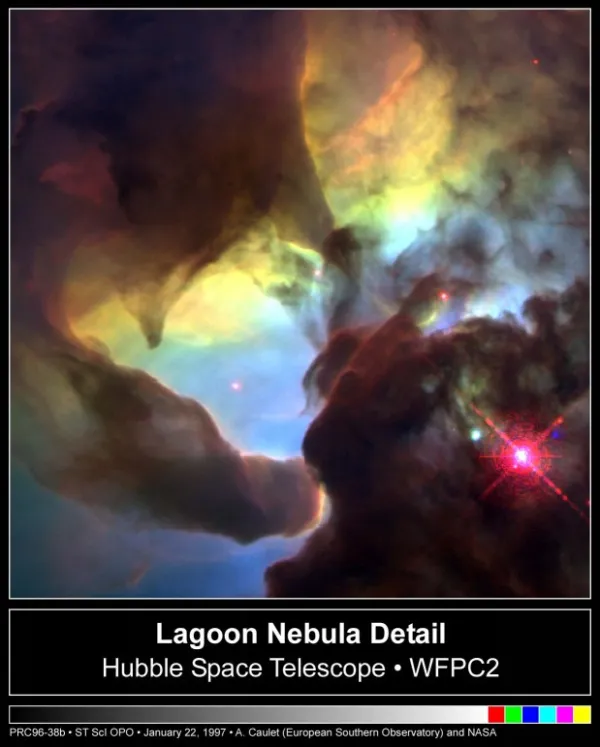
The western part of the nebula is dominated by two stars that are only three arcminutes apart. The southern star of the two is 9 Sagittarii with the spectral type O5 and magnitude 5.97 mag. This is probably the main star that makes the nebula shine, but other extremely hot stars may exist within the cloud, obscured by dark clouds. The brightest part of the nebula is only three arc minutes WSW of 9 Sagitarii: an hourglass-shaped knot with a diameter of about 30 arc seconds and called the Hourglass Nebula because of its appearance. This extremely bright part of the nebula is partly supplied with energy and made to glow by the star Herschel 36 (approx. 9.5 mag, spectral type O7) and partly by a star covered by a band of dust. The hidden star is only visible in the infrared, which is able to penetrate the dense clouds of dust. These stars may be less than 10'000 years young, roughly the same age as the Hourglass Nebula itself. An indication of recent star formation in this very active region. This part of the nebula also contains a source of radio emissions, which was first detected in 1973 by the National Radio Astronomy Observatory in Green Bank, West Virginia. [4, 15]
The HST detail of the Hourglass Nebula reveals a pair of interstellar «cyclones» about 0.5 light years long. The hot O star Herschel 36 in the centre and other hot stars are the primary sources of ionizing radiation. The strong radiation causes photo-evaporation on the surface of the surrounding clouds (shown as «blue haze»), and powerful stellar winds, which tear the cool clouds apart. Analogous to the earthly weather phenomena, the large temperature difference between the hot surface and the cool interior of the clouds, combined with the pressure of starlight, can lead to strong horizontal shear forces, which swirl the clouds into a tornado-shaped structure. Although the appearance of the dark hoses of the cloud suggests a vortex movement, this rotary movement must be verified on the basis of further spectral measurements with new equipment from the HST.
The HST images also reveal a multitude of small structures in the interstellar medium: small dark clouds called «bok globules», arc-shaped shock fronts around stars, ionized scraps, rings, knots and jets. All signs that confirm the true nature of the Lagoon Nebula as the birthplace of new stars from dusty molecular clouds. These regions serve as a space laboratory to study the evolution of the stars and the interactions of the stellar winds with the surrounding gas.
The colour-coded HST image was created between July and September 1995 with the WFPC2 through three narrow-band filters: red = ionized sulfur atoms, blue = doubly ionized oxygen atoms, green = ionized hydrogen. This colour coding does not correspond to the natural colours, since ionized sulfur atoms [S II] shine red, doubly ionized oxygen atoms [O III] green and ionized hydrogen [H II] blue-green [H β] and red [H α]. [175]
Dark Clouds in M 8
In addition to the dominant dark volume in M 8, the American astronomer Edward Emerson Barnard discovered other dark clouds and listed them in his 1919 catalog «Catalogue of 182 Dark Markings in the Sky» [239]. Barnard 88 is a peculiar comet-shaped cloud north of the open star cluster NGC 6530. The name for the very irregularly shaped dark cloud near the bright star on the east side of the nebula is Barnard 89. South of the bright star 9 Sagittarii there is another, later discovered dust cloud the number Barnard 296. The location and appearance can be found on the location card. However, Barnard seemed to have overlooked some dark clouds. [4] The bright star 7 Sagittarii (5.3 mag) west of the Lagoon Nebula is an F3 star of the main sequence. At a distance of only 240 light-years it is far in the foreground and has no relation to the nebula. [91]
| Name | Type | RA (J2000.0) | Dec (J2000.0) | Size ['] | Identifiers |
|---|---|---|---|---|---|
| Barnard 88 | DNe | 18h 04m 36s | -24° 06' 00" | 19.8 × 24 | Barnard 88; TGU H77 P6; [DB2002b] G6.30-1.23 |
| Barnard 89 | DNe | 18h 05m 00s | -24° 21' 00" | 2 × 1.5 | Barnard 89; [DB2002b] G6.12-1.43 |
| Barnard 296 | DNe | 18h 04m 06s | -24° 31' 00" | 4 × 4 | Barnard 296; [DB2002b] G5.88-1.33 |
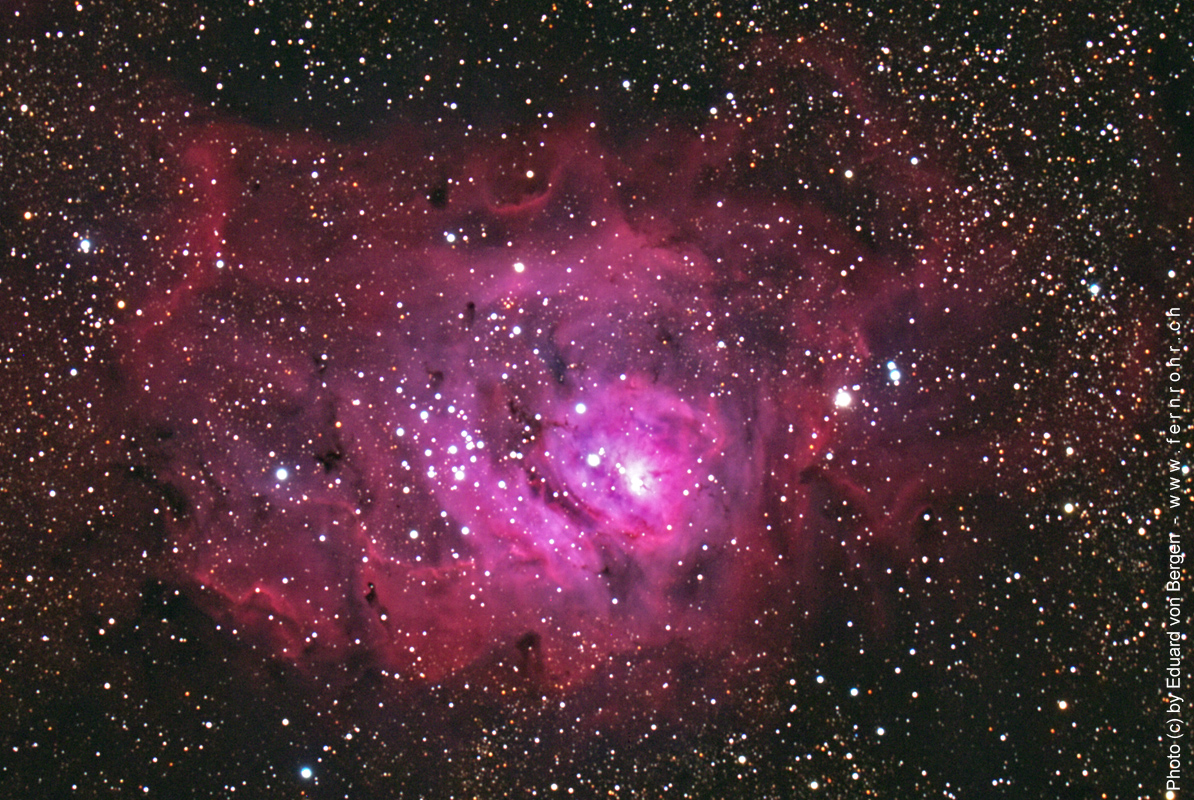
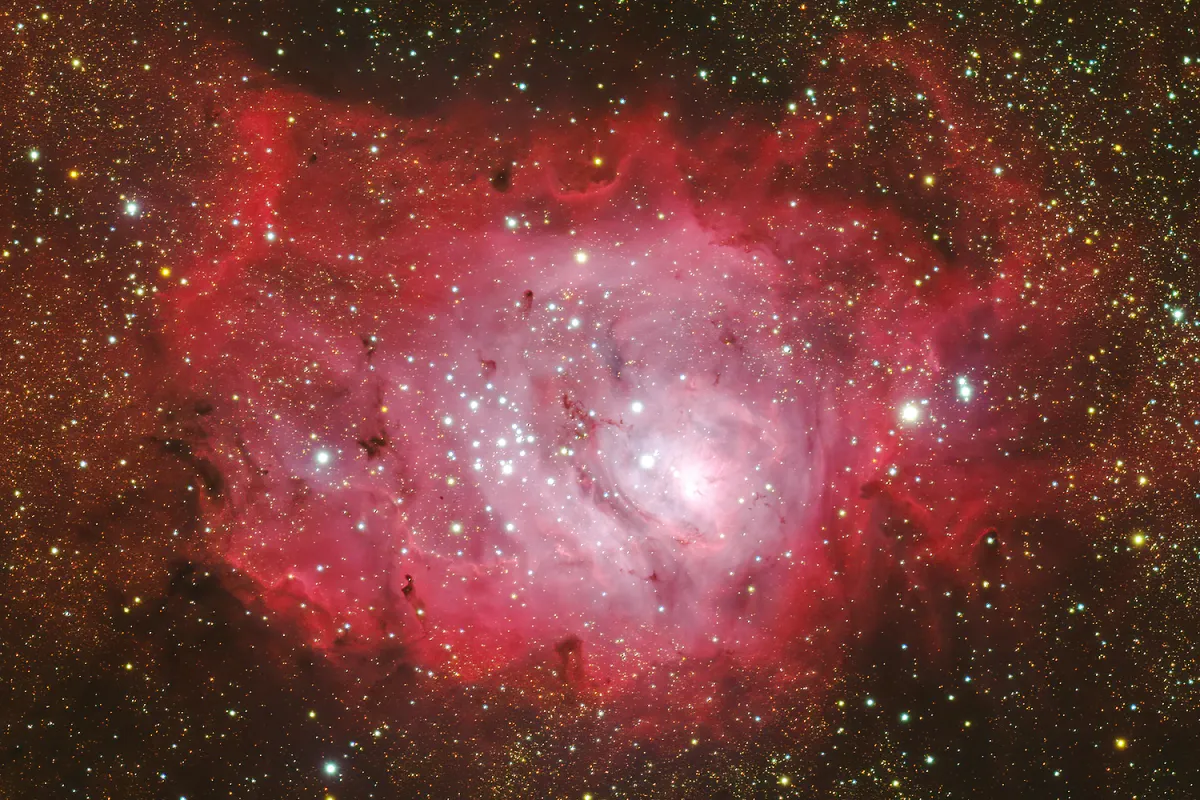
Open Star Cluster NGC 6530
The eastern part of the galactic nebula Messier 8 contains the loose open star cluster NGC 6530 as the most prominent feature. It measures about 14 arc minutes in diameter. The brightest members are subgiants of type B0 IV. Using the Lowell 42 inch reflector, CO Lampland was able to identify 18 irregularly variable stars in the cluster and the surrounding nebula in 1919. These appear to be flare stars and those of the T-Tauri Type, which are still babies and have not yet developed to the stable main sequence stage. An HR diagram created by NGC 6530 shows a typically young cluster, which only extends from the spectral type O5 to about A0. Most of the faint stars are around four to five magnitudes above normal position. They are still in the process of gravitational contraction and may not yet generate thermonuclear energy - interstellar fetuses, so to speak. The HR diagram of M 8 is similar to that of NGC 2264 in the constellation Monoceros. Both are among the youngest known star cluster. The age is estimated at a few million years. As the spectra show only a slight reddening shows, suggests that the star cluster is in front of the Lagoon Nebula. NGC 6530 is moving away at a radial velocity of about 9 km/s. [4]
| Name | RA | Dec | Type | bMag | vMag | Dim | MD | Dreyer Description | Identification, Remarks |
|---|---|---|---|---|---|---|---|---|---|
| NGC 6523 | 18 03 42.0 | -24 22 48 | EN | 5.8 | 45 × 30 | 1.250 | !!! vB, eL, eiF, with L Cl | h 3722; GC 4361; M 8; NGC 6533; LBN 25; Lagoon nebula | |
| NGC 6530 | 18 04 30.0 | -24 21 30 | OCL (II2mn) | 4.6 | 15 | 1.322 | Cl, B, L, pRi, f M 8 | h 3725; GC 4366; OCL 19; ESO 521-SC21; in Lagoon nebula (M 8) | |
| NGC 6533 | 18 03 42.0 | -24 22 48 | dup | 5.8 | 45 × 30 | 1.250 | eL, eiF, st f | WH V 13; GC 4368; M 8; NGC 6526; LBN 25; Lagoon nebula |
Finder Chart
The diffuse nebula M 8 lies over the spout of the Teapot, roughly on the same RA coordinate as Al Nasl (γ Sagittarii) and roughly one degree further north than Kaus Borealis (λ Sagittarii). Another method is to connect the stars Kaus Borealis (λ Sagittarii) - ρ Ophiuchi and to position the middle Telrad circle on about the first third. M 8 can be seen with the naked eye on a clear, dark night. The star 9 Sagitarii is 5.4 mag bright and 9 Sagitarii has 5.9 mag. Finding it is therefore quite easy. Since the nebula is quite large, it is best to choose an eyepiece with the lowest magnification. An O-III filter increases the contrast on slightly hazy nights. Roughly one and two degrees towards southeast there can the two globular clusters NGC 6544 and NGC 6553 be found. M 8 is best seen in the months of February to November.
Visual Observation
The Lagoon Nebula is already visible to the naked eye, appears clearly in binoculars and fully reveals itself in a telescope. In small and medium-sized telescopes, a UHC or OIII nebula filter helps to increase the contrast. Shapes as well as light and dark areas are clearly visible. — 14" PWO-Dobson, F:4.6 / TV-Nagler 26mm, 62x, 1.33° / OIII-Filter, Eduard von Bergen
